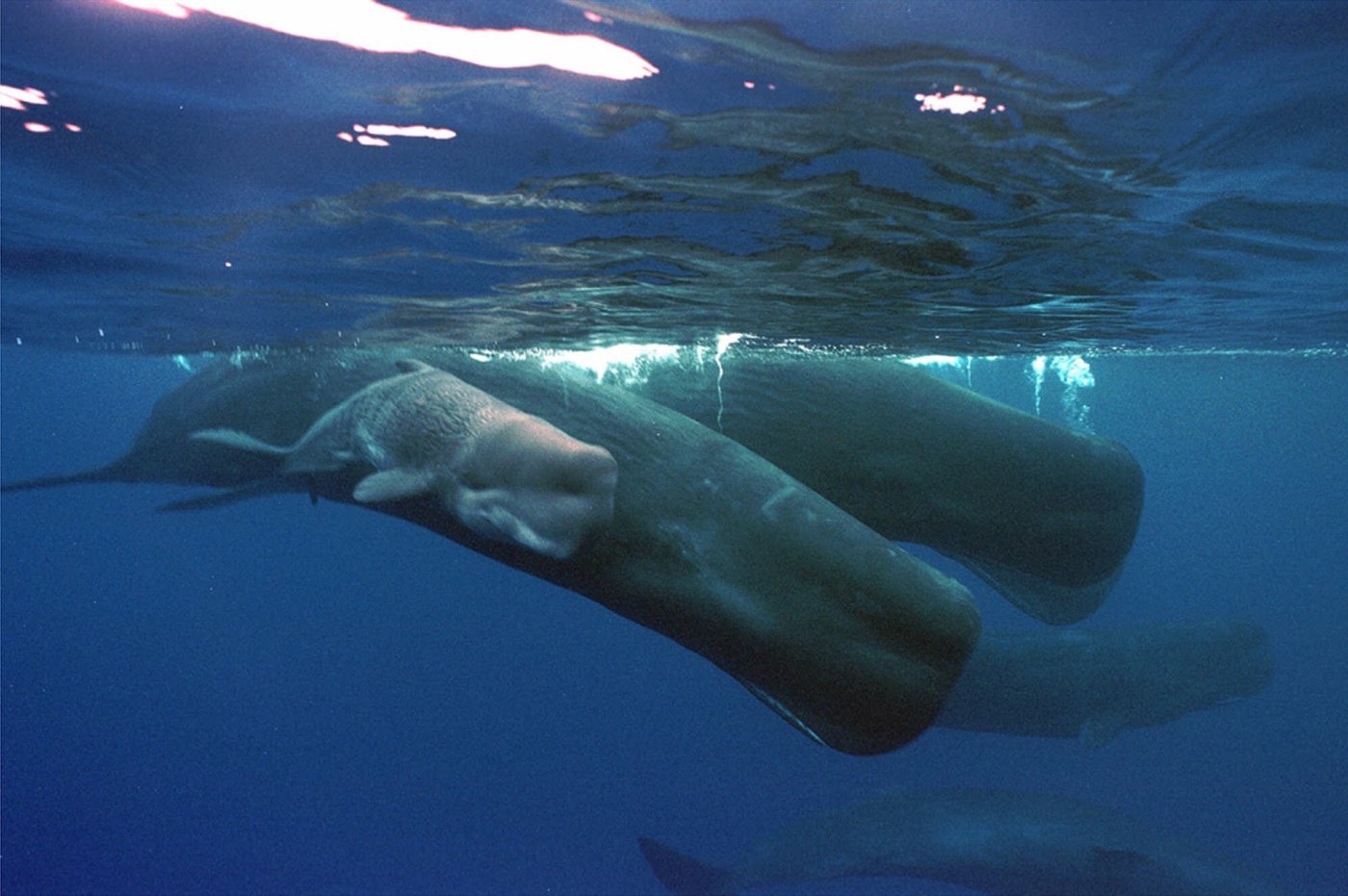MONTEREY – Hundreds of feet beneath the ocean’s surface, the planet’s largest-toothed predator hunts for prey, which could include a giant squid or even a shark.
Since the deep ocean is dark, the creature hunts by sound. It makes a series of clicks, the loudest sound produced by any animal, by forcing air through its nose and into a specialized organ. Each click lasts for a fraction of a second, their echoes are processed by its brain, which is five times larger than a human’s, to pinpoint the location of its next meal.
According to scientists at the Monterey Bay Aquarium Research Institute (MBARI), sperm whales frequent the deep waters around Monterey Bay much more than previously thought. The researchers analyzed seven years’ worth of recordings captured by an underwater microphone near Monterey Bay to see how often they heard clicks made by sperm whales.
Sperm whales off the Orange County coastline. (Photo via The Orange County Register courtesy of Mark Girardeau/Newport Coastal Adventure)
“We actually found that these animals are here quite a bit more often than we had realized,” says Will Oestreich, a researcher from MBARI and the lead author of a study published last month in Movement Ecology, a journal that covers research on animal migration.
RELATED: Monterey Bay Aquarium: Providing otter love through surrogacy program
Since sperm whales spend most of their time deep underwater, humans rarely see them. John Ryan, a researcher at MBARI who was involved with the study, said one local whale watching boat naturalist reports seeing them around once every five years. In contrast, the underwater microphone recorded sperm whales on over one-third of the days between 2015 and 2022. MBARI placed the microphone 18 miles from the coast, 3,000 feet-deep in 2015.
This study “allows us to recognize they’re a persistent part of the biodiversity here,” he says. “We did not know that. We didn’t know it from our eyeballs.”
This finding is important for conserving sperm whales, Oestreich says. “This is an endangered population of marine mammals. If we want to protect them, we first need to understand where they are.”
Ryan says that sperm whales likely benefit from recent efforts to protect other whales on the California coast, like the Blue Whales and Blue Skies program. Although sperm whales spend most of their time deep underwater, they occasionally take 10-15 minute naps near the surface, making them especially vulnerable to ship strikes. The program has reduced the chances of a fatal ship strike on California’s whales by 58%.
An underwater microphone, or hydrophone, installed on MBARI’s cabled deep-sea observatory, the Monterey Accelerated Research System (MARS), in the heart of the Monterey Bay National Marine Sanctuary. The trove of acoustic data recorded by this hydrophone gives researchers an important lens into marine life and ecosystems. (Photo courtesy of MBARI)
Oestreich and colleagues also found that the number of sperm whales off the coast of the Monterey Peninsula varies throughout the year. They identified the source of this variation by comparing the frequency of sperm whale noises to the location of a food-rich region called the North Pacific Transition Zone. This area moves throughout the year and many surface-dwelling ocean predators follow it.
The researchers found that sperm whales are most abundant around Monterey Bay when the North Pacific Transition Zone is here. While they do not follow it as closely as surface-dwelling creatures, it provides strong evidence that sperm whales migrate seasonally. This has powerful implications for our understanding of the deep ocean.
A sperm whale observed in Monterey Bay in 2022. A new study by MBARI researchers and their collaborators has revealed that sperm whales are more common offshore of California than previously believed, and has provided new evidence for seasonal migrations in this top predator of the deep sea. (Photo by Tim Huntington)
Related Articles
In East Bay siblings’ trial, jury hears key testimony about 2021 fatal shooting of missing teen
Behind the scenes at the Monterey Bay Aquarium
Tiger Woods opening his first golf apparel pop-up shop at Pebble Beach
Monterey Bay Aquarium’s Seafood Watch: A fixture in the conversation about sustainable seafood
Going against the current: What separates Monterey from other aquariums
Sperm whales “can provide insight into this understudied ecosystem that is difficult to study because it is so deep down and has many moving parts,” says Natalie Posdaljian, a researcher who studies sperm whales off the coast of Alaska who was not involved with this study. She thinks that sperm whales can tell us a lot about the deep ocean.
Dark, cold and beyond the reach of the sun’s rays, scientists used to think this environment does not have seasons. But Oestreich’s findings are part of a growing body of evidence suggesting the deep ocean does experience seasonal change. Rather than coming from changes in temperature, these seasons might come from changes in the food and nutrients that rain down from the surface.
Since the deep ocean is so inaccessible, Oestreich and colleagues did not look for the whales, they listened. Although sperm whale echolocation clicks are the loudest sound made by any creature, the sheer length of the recording analyzed for the study made the task difficult.
“Picture a song on your Spotify library, but it’s more than seven years long. That’s what we’re dealing with here,” says Oestreich.
He created a computer program that could differentiate the clicks made by sperm whales from other noises in the ocean. The program also measured the amount of time between consecutive clicks, which tells us a lot about individual whales.
“The body size of a sperm whale is correlated with the spacing between clicks,” Oestreich says. Based on this, he identified small “teenage” whales, medium-sized females, and large males in the recordings. These findings align with other acoustic studies, but contradict anecdotal reports, which suggest large males live in different areas from females and their young.
Oestreich believes his research is important for protecting sperm whales, but he also sees it as interesting in itself.
“There is a lot of value in understanding the way of life of another creature that we share this planet with. I think there is a lot of wonder in that. I hope others find a degree of joy and fascination in the pure discovery of this sort of science.”
To listen to sperm whale hunting click here












